I have been working on this project for a long time, and finally finished it. The concept is simple: a 3-way speaker with full-range directivity control.
Design and optimization of waveguides was done with Fusion 360 (modelling) and AKABAK (simulation). The loudspeaker looks like this:
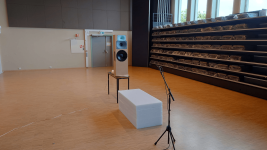
It uses the bliesma T25B, Kartesian Mid120_vHE, and Kartesian WOM300_vDIY. Waveguides are 3D-printed. Cabinet is 25mm MDF, 30mm for front baffle. Internal bracing is 16mm MDF. Amplification/crossover is hypex FA123. I also have a capacitor on the tweeter and two passive notch filters on the midrange (which reduces distortion in the passband).
Measurements were done with 16ms gating (62.5Hz resolution) and there is thus no data below that, so what you see below that is interpolated and almost certainly wrong. Furthermore 1/24 octave smoothing was applied, as the mid-high frequencies are a little too wiggly to easily read without it. Note that the image above is not representative for how these measurements were done, that image is from a measurement session in early autumn.
Spinorama:
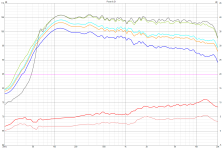
Horisontal radiation from 70Hz:
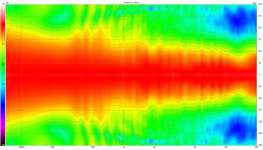
Vertical radiaation from 70Hz
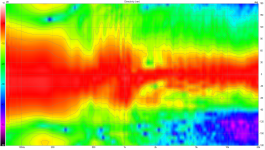
Some off-axis angles normalized to on-axis. 160 degrees was selected as that is where the woofer shows the strongest rear attenuation:
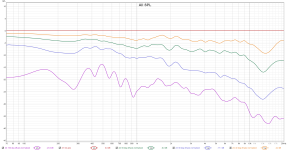
Finally, here is a comparison of the loudspeaker simulation (left, only simulated up to 5kHz, vituixCAD makes assumptions above that) and the measured sample (right):
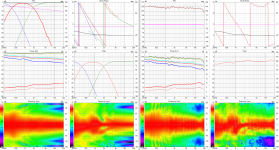
The agreement between simulation and reality is remarkably good!
Finally, I have been listening to it for the past two days and adjusting a bit to taste. Here are moving mic measurements from my room, ~2m distance, no EQ/correction applied:
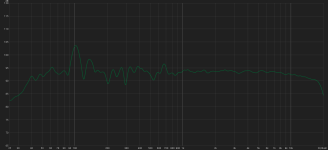
Overall I find it a bit bright and lacking bass (which makes sense, it's designed to be used with subwoofers). Due to my relatively short listening distance and the output capacity I've taken the freedom to increase bass output a bit, as well as use peak filters on the 102Hz and 135Hz resonances. I've also brought up the lower midrange/upper bass slightly. It now looks like this:
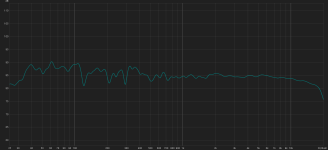
I find it enjoyable, but am experimenting with a -1 to -2dB high shelf filter, as it still sounds a little sharp at times.
If I were to build it all over again, there are changes I would make, but overall I am very happy. Feel free to ask any questions!
Design and optimization of waveguides was done with Fusion 360 (modelling) and AKABAK (simulation). The loudspeaker looks like this:

It uses the bliesma T25B, Kartesian Mid120_vHE, and Kartesian WOM300_vDIY. Waveguides are 3D-printed. Cabinet is 25mm MDF, 30mm for front baffle. Internal bracing is 16mm MDF. Amplification/crossover is hypex FA123. I also have a capacitor on the tweeter and two passive notch filters on the midrange (which reduces distortion in the passband).
Measurements were done with 16ms gating (62.5Hz resolution) and there is thus no data below that, so what you see below that is interpolated and almost certainly wrong. Furthermore 1/24 octave smoothing was applied, as the mid-high frequencies are a little too wiggly to easily read without it. Note that the image above is not representative for how these measurements were done, that image is from a measurement session in early autumn.
Spinorama:

Horisontal radiation from 70Hz:

Vertical radiaation from 70Hz

Some off-axis angles normalized to on-axis. 160 degrees was selected as that is where the woofer shows the strongest rear attenuation:

Finally, here is a comparison of the loudspeaker simulation (left, only simulated up to 5kHz, vituixCAD makes assumptions above that) and the measured sample (right):

The agreement between simulation and reality is remarkably good!
Finally, I have been listening to it for the past two days and adjusting a bit to taste. Here are moving mic measurements from my room, ~2m distance, no EQ/correction applied:

Overall I find it a bit bright and lacking bass (which makes sense, it's designed to be used with subwoofers). Due to my relatively short listening distance and the output capacity I've taken the freedom to increase bass output a bit, as well as use peak filters on the 102Hz and 135Hz resonances. I've also brought up the lower midrange/upper bass slightly. It now looks like this:

I find it enjoyable, but am experimenting with a -1 to -2dB high shelf filter, as it still sounds a little sharp at times.
If I were to build it all over again, there are changes I would make, but overall I am very happy. Feel free to ask any questions!
Great!The loudspeaker looks like this:
So you included a passive cardioid woofer enclosure using side slots?
Did you also simulate this?
Thanks!Great!
Yes.So you included a passive cardioid woofer enclosure using side slots?
I did, in AKABAK. The results are pretty close overall, but the real-world results actually show higher rear attenuation than the simulation (lowest attenuation in simulation is about 12dB, lowest in reality is more than 15dB). If you look at the simulated - real comparison you can see that the woofer's directivity is quite similar. The real example has about 0.5-1dB higher SPDI below 200Hz (not shown).Did you also simulate this?
Wow, nice directivity!
Would you mind sharing how you simulated this in AKABAK?
How is distortion?
Would you mind sharing how you simulated this in AKABAK?
How is distortion?
Copying what I wrote on audiosciencereview: "Due to the measurement distance (3 meters) there is substantial room influence, even for such a big room (REW cannot gate distortion measurements), because of this the distortion measurements are very corrupted below 200Hz (in fact you can see it in the measurement I will post here at ~220Hz). This is measured at a level of 95dB.How is distortion?
2nd order distortion is a little high from 300-600Hz, however this is perceptually benign, and still falls below the worst case masking threshold. All other orders are extremely low. The spike in distortion at 800Hz is a resonance in the midrange driver, I do not think it deteriorates sound quality meaningfully. Above 900Hz distortion is practically nonexistent."
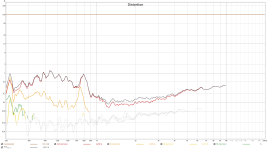
Additionally, it seems there may be some QC issues with these drivers (or QC tolerances are not the highest), because I have had 4 pairs which all measured quite different in terms of distortion (and all varied a bit in exactly where the ~800Hz resonance was). The driver in the other speaker does not show that 3rd order distortion spike at 700Hz, for example, and has somewhat lower 2nd order distortion as well. In any case I think the distortion is low enough to not be worrisome, particularly at my 70-75dB average listening levels.
That would be an entire thread by itself. If you're not already familiar with AKABAK, explaining it would honestly do no good. The process was like this (simplified):Would you mind sharing how you simulated this in AKABAK?
1. Draw the waveguide in fusion, with some assumptions about what would yield the desired performance.
2. Export as .step.
3. Import to gmsh, mesh it and export said mesh.
4. Import said mesh to AKABAK.
5. Set up simulation as necessary (for midrange waveguide I simulated the whole cabinet, for tweeter waveguide I mostly simulated in infinite baffle due to mesh size requirements).
6. Observe results and adjust the waveguide geometry, then move back to step 2. Do this until results are satisfactory.
For the cardioid woofer I made a simplified drawing with relatively few mesh elements that solves in less than 30 seconds, then adjusted the position, size, and number of slots, as well as the damping in the cabinet until I had satisfactory results. In my attempt to match reality to simulation I did a simulation of the output of the near-field output of the slits in AKABAK, and then measured the same thing in real life, adjusting damping material until the resulting responses were similar.